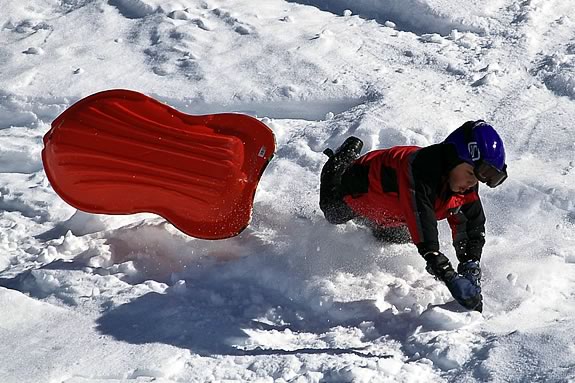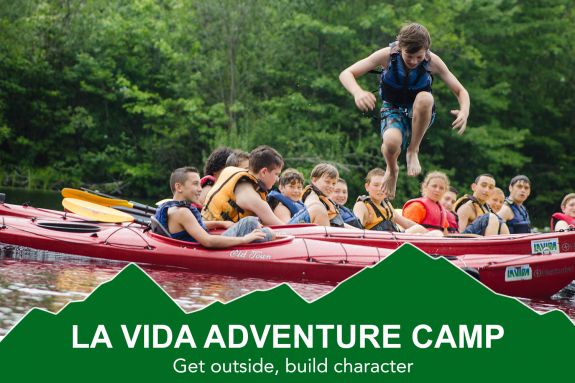
Sledding is a great way to kill an afternoon on snowy days, have some fun with the family and get some outdoor winter exercise. I loved sledding as a kid, but now when I see 'B' pretending to have 'accidents' on the sledding hill we made in our front yard, I cringe to think of the possible dangers involved in sledding. Wiping out is fun, until somebody gets hurt.
According to a study published in the September 2010 issue of the journal Pediatrics, over 20,000 children and teen sledders visit the emergency room annually between 1997 and 2007. These injuries include scrapes, bruises and bumps, but 26% are fractures and 33% are head injuries, with many of those being serious brain trauma.
Today's sleds are designed to give your child the rush of flying down that hill at top speed. Some have great control and are properly designed to minimize injuries, but inner tubes and plastic saucers are based on 'pray as you go' technology. To keep it safe one general rule to follow is 'Be Aware of Your Surroundings'. Most injuries occur from high speed impact with an immovable object or another person/sledder, so its best to find a sledding hill that's wide open and has little or no obstructions.
Follow these sledding safety tips and tricks, and everybody will be sure to have a great time and make it home safe and sound:
- Children should be supervised by a responsible adult while sledding.
- Make sure someone has a cell phone to call 911 in case of an emergency.
- Kids under 5 should have an adult sled with them.
- Use your supervising time to teach proper sledding techniques
- Protect your head!
- Wear a helmet (you can even use a bike helmet)
- Sledding head first greatly increases the risk of head injury.
- Sit or lay on the sled with your feet facing downhill, your legs are better designed at absorbing impact than your head.
- Wear eye protection.
- Ski Goggles are designed to stay on your head when you fall
- Sunglasses should be secured using a strap that fits snugly around the back of your head.
- Injuries are serious
- Take all injuries seriously until you can figure out the extent of the damage.
- If somebody is seriously hurt or unconscious, especially with a head injury, call 911 immediately.
- If the person cannot move on their own, minimize moving them until aid arrives.
- Try to keep them warm.
- Stay with them until help arrives.
- Try to keep people a with head injury conscious.
- Bring a first aid kit!
- Make sure all participants know how to stop their sled.
- Rolling off of a moving sled is the best way to dismount in an emergency.
- Bring a shovel.
- A shovel will help you pad some obstructions by shoveling loose snow in mounds around them.
- If somebody is accidentally buried in snow, you'll have an efficient way of digging them out.
- Proper dress makes the difference

- dress to stay dry, in layers under a water proof shell
- thick gloves or mittens are crucial for keeping hands warm.
- protective boots keep feet warm and help absorb impact.
- Avoid scarves and othe loose clothing that could serious injury if they get snagged.
- brightly colored clothes makes it easier for other people on the sledding hill to see you (avoid wearing white).
- Have the right frame of mind
- Don't sled while tired, sick, medicated or otherwise distracted
- Scout the sledding area.
- Choose a hill with a manageable slope and a long path.
- Make Sure you can see your surroundings clearly.
- Don't sled after dark or when visibility is bad due to fog, rain or snow.
- Be aware of "No Trespassing" signs
- It's always right to respect somebody else's property
- Be aware that snow banks may hold hidden dangers like rocks or stumps or hydrants
- Make sure the sledding path does not cross traffic or roadways
- Assess the threat of hazardous obstacles like:
- walls
- large trees
- trash bins
- fences
- rocks
- picnic tables
- telephone poles.
- Make sure there is enough room to come to a stop!
- How 'Hard' is the hill? Is the snow loose enough to absorb some impact?
- check for ice or bare spots, and make a mental note of the spots to avoid
- shovel loose snow on harder areas to soften the impact of falling on them.
- Avoid sledding near bodies of water, like brooks, large puddles and ponds
- Sledding time is over for the person who gets drenched!
- Proper equipment handling
- An overloaded sled is dangerous, if it's made for one person, use it that way.
- Don't stand on a sled.
- Don't use a broken sled
- A cracked piece of plastic or a loose piece of metal can cause a lot damage of on a moving sled!
- The sled should match the slope.
- Inner tubes, saucers and snow disks are fast, not easy to handle and are great on a wide slope with a lot of room.
- Straighter toboggan & rail type sleds are more maneuverable and are better for tighter trails where you need more control.
- Be safe, polite and courteous
- Wait your turn.
- Show respect for younger children who may be near you.
- Don't cut off others on the hill.
- A moving sled has the right of way, stay out of their way.
- Don't try to sled into another sledder or person.












